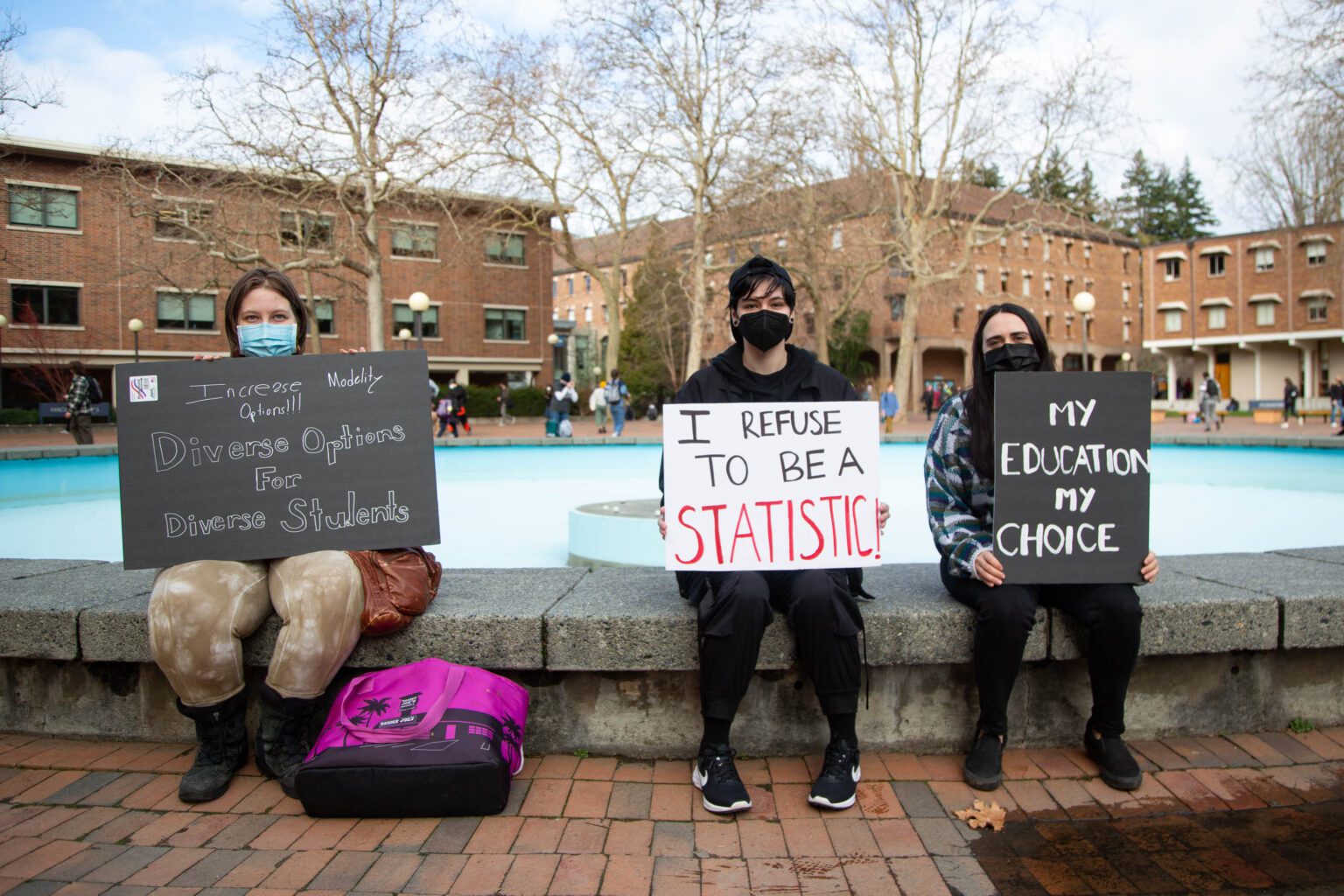Western Washington University students set out for Red Square or joined via Zoom Monday to demand that the university provide multi-modal learning, clearer COVID-19 guidelines and more support for students and faculty to ensure a safe learning environment.
Multi-modal learning would require in-person classes to have an online component, giving students the choice to return to campus or stay online. Many students said they fear contracting COVID-19 from packed lecture halls, while others crave the social interactions of in-person learning. Multi-modal learning would give students the individual choice between in-person or online learning. More than 600 students have signed an online petition in support of it.
But Western officials said they do not have the infrastructure to provide that option to students.
“It requires the faculty member to interact with both student groups concurrently, which is very difficult without additional trained classroom help,” Western spokesperson John Thompson said in an email.
Last October, the university and the United Faculty agreed that instructors would not be asked to teach a section for both remote and in-person students, and if they were, they’d receive extra pay due to the added workload.
Much of the frustration came from the lack of online learning opportunities for immunocompromised and disabled students or those who are in close contact with other at-risk people.
“I don’t have a way to protect [my family] and continue my classes,” said student protester Astrid Ervin, who lives with multiple immunocompromised people.

The university did not extend the deadline for students to request remote participation and asks students who need accommodation to inquire through the university’s Disability Access Center. The university also declined to suspend attendance policies, but does require faculty to work with students in the event that they fall ill.
At the start of the quarter, 89% of classes were online or hybrid. Following the first few weeks online, a nominal number of faculty chose to remain online for two more weeks, said Thompson. In another agreement between the university and the UF, faculty are allowed to move to remote instruction for two weeks or less due to COVID-19 related disruptions.
When Western returned for winter quarter, the university decided to spend the first three days online to give students time to test for COVID-19 and to get booster vaccines. Even with a 97% vaccination rate, 221 students and 33 employees tested positive for COVID-19 between Jan. 3 and Jan. 9. In all of fall quarter 2021, Western reported just 169 positive cases.
On Jan. 10, students returned in-person briefly before Western announced they were going back online for the following two weeks.
“We know that omicron has a significantly higher transmission rate, and so we are taking this precaution to help reduce transmission and the stresses on our hospitals and other health resources,” President Sabah Randhawa said in a letter to students.
Many students were frustrated because the announcement came just hours before the deadline for students to drop all classes in winter quarter and receive a full refund.
“There’s the feeling that the school isn’t caring about our health and safety and just caring about money,” Western student Vemund Aaro said. Aaro was one of the main organizers of Monday’s protest and the petition.
During the closure, students on campus still had access to the dining halls and the recreation center. Emma Whisler, a senior living on campus, said she would receive two to three exposure notifications a day for simply going to the dining hall between doing her online classes from her dorm.
“The crazy thing is, there’s not a limit on the number of people in the dining halls, as well as no regulations of how long you can be there, how long you can have your mask off, or space regulations between groups of people,” Whisler said.
In the second week of the quarter, 288 cases were reported and 177 more the following week. This quarter, Western has distributed 5,803 tests through their health center and held multiple vaccine booster clinics.
On the first day back to in-person classes on Jan. 24, while many students were excited to be learning in the classrooms again, many also felt wary of the crowded lecture halls and rooms with poor ventilation.
“The first day in-person, we had a seat between us, but that wasn’t really 6 feet of space,” Western student Matthew Phillips said about a lecture class. “We’re doing the best distancing that we can, but it’s not up to the standards we were given.”
Aaro said the return in-person amid a spike in cases caused him to organize with other students who felt that Western could take more steps to ensure a safe learning environment.
“If nothing else comes of all this, I hope that Western at least sees they’re not doing enough,” Aaro said.
A previous version of this story incorrectly stated the percentage of classes in-person or online. The story was updated to reflect his change on Feb. 1 at 11:30 a.m. Cascadia Daily News regrets the error.




